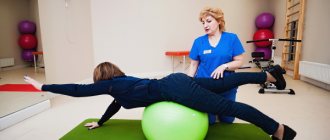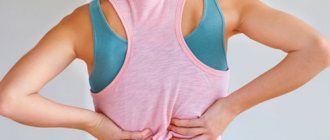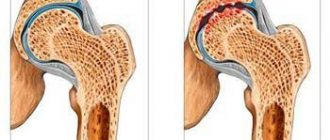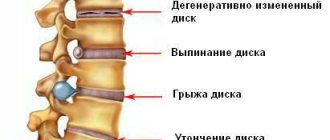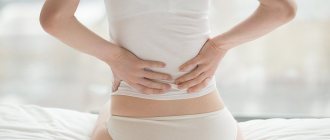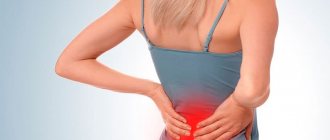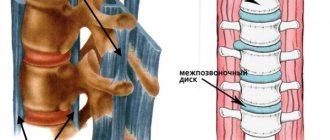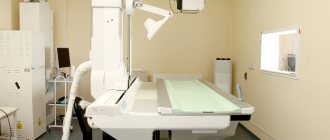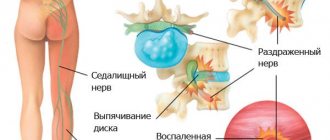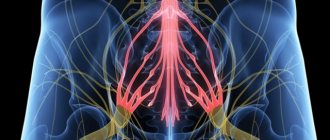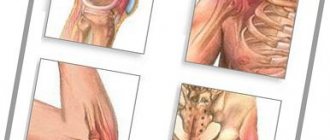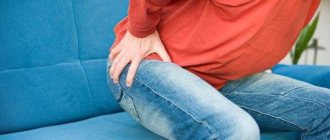13 July 2020
10326
0
0 out of 5
Lower back pain is one of the most common health complaints. They can be of varying intensity and nature, arise under the influence of various factors and often become the cause of loss of performance. Often the pain is chronic and periodically intensifies, but even in such cases, not all men are in a hurry to see a doctor and begin treatment, perceiving discomfort in the lower back as a price for hard work or inevitable age-related changes. Such an attitude can play a cruel joke on a man, depriving him of the ability to work and move normally not only temporarily, but forever. Therefore, it is very important to establish the cause of lower back pain and carry out proper treatment before the existing disease leads to irreversible changes.
Main causes of lower back pain
The overwhelming number of visits to the doctor with such a complaint are associated with pathology of the lumbar spine - with degenerative-dystrophic changes in the osteoarticular apparatus of the back. However, the pain may be caused by diseases of an infectious-inflammatory or other nature. Let's take a closer look at them.
Ankylosing spondylitis
Another name is ankylosing spondylitis (spondylitis). One of the systemic connective tissue diseases. Characterized by non-infectious inflammation of the spinal structures. The vertebrae gradually fuse with each other, which limits the range of movements in the affected area - ankylosis is formed. The paravertebral ligaments ossify. Gradually, the spinal column completely loses the ability to bend and turns into one solid bone.
It debuts in young people, the first symptom is pain in the back, in the lumbar region of the back, which, as the pathology progresses, spreads to other parts of it. At first they occur only from time to time, but very soon they become permanent, decreasing temporarily only after taking the drug.
Shpidonov Gennady Stanislavovich
Neurologist
Rostov State Medical University (neurology)
10 years of experience
Other characteristics of pain:
- accompanied by a feeling of stiffness of movements;
- more pronounced in a state of rest, especially painful in the second half of the night, in the morning;
- their intensity decreases after active movements - physical exercise, as well as after taking NSAID medications.
It is accompanied by damage to joints located remote from the spine - morning stiffness occurs in them, and during exacerbation there is intense pain, swelling and hyperemia (redness) of the soft tissues around them.
Hernia and osteochondrosis
Osteochondrosis is characterized by malnutrition and subsequent destruction of the cartilage tissue of the intervertebral discs, hernial protrusion of the latter towards the spinal canal, the formation of marginal growths of bone tissue in the areas adjacent to the affected discs, as well as arthrosis of the spinal joints.
All these changes lead to the appearance of dorsalgia - a constant aching or shooting acute pain in the lower back, often radiating (radiating) to the buttock area, to the legs, accompanied by weakness of the limbs and numbness. Locally at the site of the lesion, it is possible to palpate (feel) the tense paravertebral muscles, and the patient at this moment notes an increase in discomfort. Pinching of the nerve roots by a spasmodic muscle is accompanied by a burning sensation, tingling, numbness or a feeling of “crawling goosebumps”.
Intervertebral hernia is a complication of osteochondrosis, in which a fragment of the intervertebral disc protrudes or falls into the spinal canal. At an early stage it is asymptomatic, but as it progresses it leads to gradually increasing frequent back pain and limited range of motion in the affected part of the spine.
Unpleasant sensations intensify with high physical activity, static load on the lower back (during a long stay in a standing or sitting position), limit movements, and sometimes there are “lumbagoes” radiating to one or both buttocks and lower limbs. Severe hernias are accompanied by decreased sensation in the legs, which does not recover after rest, as well as dysfunction of the reproductive system and pelvic organs.
Kyphosis and scoliosis
With curvature of the spine, the back also hurts in the lumbar region. According to its anatomy, the spinal column is not a strictly straight structure, it has physiological curves: forward - cervical and lumbar lordosis, backward - thoracic and sacral kyphosis. The bends are necessary to ensure that the load is distributed evenly across the vertebrae; they help the post to absorb shock during movements.
In some congenital diseases, the curves are formed incorrectly; changes in their depth can also be observed in a number of acquired pathologies. Lumbar lordosis is often smoothed out against the background of spondylitis and spondyloarthrosis (degenerative-dystrophic and inflammatory processes in the joints between the vertebrae). Kyphosis also forms due to injury.
Lumbar scoliosis (sideways curvature) develops in response to curvature of the thoracic spine compensatory (the body strives to gain stability and distribute the load more evenly). Visually, it is manifested by an S-shaped back, asymmetry at the waist and shortening of the lower limb. Lumbar scoliosis is a fairly rare condition - the curvature develops mainly in the thoracolumbar column.
The initial stages of kyphosis and scoliosis occur without any symptoms. As the disorders progress, the patient notes fatigue of the back muscles, especially towards the end of the working day, periodic pain appears, which later becomes constant. By nature, these are unpleasant, dull, pressing or aching pains, more pronounced during exercise, less so after rest.
Spondyloarthrosis
A degenerative-dystrophic disease characterized by the destruction of articular cartilage in the vertebrae and the formation of bone growths on them - osteophytes. As a result, the spinal canal narrows to the point that in some areas the spinal cord begins to be compressed. In recent years, spondyloarthrosis has become significantly younger - it develops in people who have reached 30-35 years of age, but more often in mature and elderly people.
The signs are:
- chronic low-intensity or moderate-intensity pain at the lumbar level, spreading to the buttock, hip joint area on the right or left, intensifying with exercise, as well as during walking or long standing, decreasing after rest;
- palpation - muscle tension and soreness at the site of the lesion;
- decreased mobility of the spine;
- when the spinal cord is compressed - numbness, weakness of the lower extremities, dysfunction of the pelvic organs.
Protrusion
It is characterized by the appearance of an unnatural protrusion of the intervertebral disc while maintaining the integrity of its fibrous ring. It is a consequence of the progression of osteochondrosis and other degenerative diseases. If timely assistance is not provided to the patient, it leads to the formation of a hernia.
Factors provoking the development of protrusion:
- spinal injuries;
- increased load on the lower back as a result of a person’s excess weight or work associated with heavy physical labor or heavy lifting;
- multiple microtraumas of the intervertebral disc;
- weakness of the back muscles;
- sedentary lifestyle;
- heredity.
Manifestations of this pathology are:
- feeling of discomfort, tension, chronic pain in the affected area of the back
- decreased range of motion in the area of protrusion;
- chilliness, numbness, discomfort in the lower extremities.
Arthritis
Arthritis of the joints of the spine is a fairly rare problem, but its occurrence significantly affects human health. This is an inflammatory process of an infectious or non-infectious nature, which is accompanied by pain in the affected joints. It can be chronic, being dull and aching, or be acute, sharp, severe, taking on the character of lumbago in the lower back that occurs after overwork or hypothermia. There is pronounced stiffness in the back after a long stay at rest in one position.
Osteomyelitis
A serious disease of a bacterial nature, characterized by purulent-necrotic inflammation of bone tissue. Initially, it is acute in nature - a paroxysmal, sharp, bursting pain appears, which, if left untreated, becomes chronic - its intensity decreases, its character changes to aching, dull, constant. These sensations are more pronounced when moving, but at rest they also persist and do not go away completely. There are also manifestations of general intoxication of the body - low-grade fever (slight increase in body temperature), weakness, fatigue, headache, sweating.
Pancreatitis
It is also accompanied by back pain: if the head of the pancreas is affected, it hurts in the right hypochondrium, the body - in the epigastrium (upper abdomen in the middle), the tail - in the left hypochondrium. If the inflammatory process affects the entire gland completely, the pain is characterized as girdling, radiating to the lower back, groin area, and perineum. It occurs after eating or physical activity, it can be pulling, cutting, stabbing, and sometimes occurs in the form of severe attacks.
Spinal stenosis
It is a complication of protrusion or herniation of the intervertebral disc. These pathological formations compress the roots of the spinal nerves, causing disruption of their function: numbness, weakness, tingling, dim comfort along the nerve. The pain is also observed at rest, and when a person walks, it intensifies when trying to straighten the back, and decreases when bending it forward.
Facet syndrome
It occurs as a consequence of degeneration of facet (formed between the articular processes) joints, which, in turn, develops against the background of pathology of the intervertebral discs. Damage to the discs leads to an increase in the load on the facet joints - inflammation is initiated in them, and then spondyloarthrosis - degeneration. This pathology affects 4 out of 5 patients aged 80 years and older.
Shpidonov Gennady Stanislavovich
Neurologist
Rostov State Medical University (neurology)
10 years of experience
Pain occurs locally in the area where the affected joints are located, intensifies when bending the body or during rotation in the lower back, as well as during prolonged standing and when changing body position from sitting to lying down and vice versa. It can radiate to the groin, buttock, lower limb on the affected side, and be cramping. Morning stiffness lasting up to an hour is typical, with an increase in the strength of unpleasant sensations towards the end of the day.
Symptoms
Pain in the lumbosacral region is the main symptom of lumbago, lumbodynia, and lumbar ischialgia.
- The pain may radiate down the front, side or back of the leg (lumbar ischialgia), or it may be localized only to the lower back (lumbago, lumbodynia).
- The feeling of lower back pain may intensify after exercise.
- Sometimes the pain may be worse at night or when sitting for long periods of time, such as during a long car ride.
- There may be numbness and weakness in the part of the leg that is in the area of innervation of the compressed nerve.
For timely diagnosis and treatment, a number of criteria (symptoms) deserve special attention:
- Recent history of trauma, such as a fall from a height, a traffic accident, or similar incidents.
- The presence of minor injuries in patients over 50 years of age (for example, a fall from a small height as a result of slipping and landing on the buttocks).
- A history of long-term use of steroids (for example, these are patients with bronchial asthma or rheumatological diseases).
- Any patient with osteoporosis (mostly elderly women).
- Any patient over 70 years of age: at this age there is a high risk of cancer, infections and diseases of the abdominal organs, which can cause lower back pain.
- History of oncology
- Presence of infectious diseases in the recent past
- Temperature over 100F (37.7 C)
- Drug use: Drug use increases the risk of infectious diseases.
- Lower back pain intensifies at rest: as a rule, this type of pain is associated with oncology or infections, and such pain can also occur with ankylosing spondylitis (Bechterew's disease).
- Significant weight loss (without obvious reasons).
- The presence of any acute dysfunction of the nerve is a signal for urgent medical attention. For example, gait disturbances and foot dysfunction are typically symptoms of acute nerve injury or compression. Under certain circumstances, such symptoms may require emergency neurosurgery.
- Bowel or bladder dysfunction (both incontinence and urinary retention) may be a sign of an emergency that requires emergency treatment.
- Failure to respond to recommended treatment or increased pain may also require seeking medical help.
The presence of any of the above factors (symptoms) is a signal to seek medical help within 24 hours.
Localization of pain in the lumbar region
By the location of the pain, one can indirectly judge its possible cause. But it is important to understand that this is just a guess and does not replace consultation with a doctor.
Pain above the lower back, but below the shoulder blades
It may be based on:
- diseases of the lower thoracic and/or lumbar spine of a degenerative-dystrophic, traumatic or other nature;
- osteoporosis;
- muscle pathology (tension, spasm of muscle fibers);
- benign and malignant neoplasms (tumors);
- diseases of the digestive system (pancreatitis).
Pain below the waist
Can talk about the following diseases:
- osteochondrosis of the lumbosacral spine;
- osteoporosis;
- diseases of the gallbladder, intestines;
- pathology of the genitourinary system (pyelonephritis, urolithiasis, inflammation of the ureters).
In women, this symptom may be accompanied by a complicated pregnancy (for example, one with a threat of miscarriage), premenstrual syndrome, and menstruation itself.
Lower back pain that occurs when internal organs are damaged is called referred pain. They are secondary in nature and are accompanied by other symptoms:
- abdominal discomfort;
- bloating;
- nausea, vomiting;
- bowel dysfunction (frequency, constipation);
- increased or difficult urination, pain during urination;
- increase in body temperature.
If there are no other symptoms, and pain occurs after a long stay in one position, heavy lifting or long walking, it is probably associated with problems in the musculoskeletal system, and you should first undergo an examination to exclude this particular cause.
Left lower back pain
Sudden, acute pain in the left side, radiating to the left shoulder blade, the left half of the neck, may be a manifestation of myocardial infarction, requiring emergency treatment. Also, a sudden sharp (“dagger”) pain in this area of a piercing, cutting nature is a sign of perforation of a stomach ulcer. This is a dangerous, even life-threatening condition that you need to be aware of in order to begin treatment as early as possible.
In other cases, this symptom is a sign of a pathological process of the musculoskeletal system:
- posture disorders;
- osteochondrosis;
- radiculitis, radiculopathy.
More often it is aching, occurs during a sedentary lifestyle, after physical activity on the lower back (long walking, sitting), and does or does not go away after rest.
Right lower back pain
Cramping or dull, aching pain may be a sign of kidney disease or reproductive system disease.
A gradually increasing intensity of sensations and pain when touching the affected area indicate the presence of an inflammatory process of an infectious or non-infectious nature.
Sharp, acute pain, like being hit with a dagger, that occurs suddenly is a symptom of perforation of a stomach or duodenal ulcer, internal bleeding, or rupture of the appendix.
Pulling sensations originating in the spine and spreading to the right side are a sign of muscle strains, radiculopathy or other diseases of the musculoskeletal system.
Lower back pain when coughing
The main reasons are the following:
- osteochondrosis;
- facet syndrome (if you relax the muscles on the affected side, reduce the load on the damaged joints, leaning towards them, the intensity of the discomfort decreases);
- herniated disc in the lumbar spine (usually accompanied by decreased sensitivity of the lower extremities or dysfunction of the pelvic organs);
- stenosis (narrowing) of the spinal canal (accompanied by intermittent claudication, impaired sensitivity and movement in the legs);
- radiculopathy;
- kidney diseases.
Lower back pain: what to do?
Low back pain is a symptom of a disease that requires treatment. Therefore, it is necessary to consult a doctor. But in the event of a sudden attack of acute pain (“lumbago”, typical of radiculitis), first of all, it is necessary to relieve the pain syndrome. Doctors advise:
- use gentle heat. Tie a woolen scarf or woolen belt around your lower back;
- take painkillers;
- It is necessary to take a position that allows you to relax your back muscles. It is recommended to lie on your back, on a hard, flat surface (board); The legs should be raised and bent at the knees, for which a rolled blanket or pillow should be placed under them. (It is not advisable to lie on the floor; there may be a draft).
The proposed pose is not a dogma. The patient should feel relief, so other positions are possible; for example, lying on a board, place your legs bent at the knees on it, holding a pillow between them. You can try lying on your stomach and stretching your legs, placing a bolster under your ankle joints. If the severity of the pain has been relieved, this does not mean that a doctor is no longer needed. Without proper treatment, attacks will recur, and the situation as a whole will worsen.
Types of severe back pain that radiates to the legs
When describing what back pain means, we want to focus on this sensation radiating to the legs. Usually it occurs when the nerve roots are damaged - when they are pinched by a spasmodic muscle or damaged by osteophytes, however, depending on the nature of the discomfort, a connection can be found with other pathologies.
Severe pain
They radiate to the legs, back of the foot, and sometimes affect the sacral spine. In most cases, they are caused by compression of the sciatic nerve by the fibers of the spasmodic piriformis muscle; they intensify when bending over, walking, or during coughing. If compression persists for a long time, atrophic processes in the gluteal muscle on the affected side are possible.
Osteochondrosis may also be the basis of this symptom. Accompanied by numbness of the limbs and a crawling feeling.
Acute pain
Arising suddenly, extending to the outer side of the thigh, they are a manifestation of the onset of an intervertebral hernia or neuropathy of the lateral cutaneous nerve of the thigh. They are also characterized by a burning sensation, numbness, tingling, crawling, and weakness of the thigh muscles.
Drawing, aching pain
If they radiate to the buttock and thigh, then they indicate the possible presence of an intervertebral hernia, disc protrusion, ankylosing spondylitis, subacute inflammation of the sciatic nerve in the lumbar region, or, less commonly, a spinal cord tumor.
Chronic pain
They are also a consequence of secondary damage to the sciatic nerve in degenerative-dystrophic diseases of the lumbosacral spine, protrusions or herniations of intervertebral discs. They become more intense after physical activity on the lower back, prolonged sitting or lying on an uncomfortable surface, and a sedentary lifestyle.
Displaced pains
They are also called reflected. They occur secondarily when the pathological process is localized in the pelvic organs - the ovaries, fallopian tubes in women, the prostate in men, as well as in the case of damage to the organs of the urinary system or rectum.
Diagnosis of the causes of pain syndrome
In order to determine the causes of lower back pain, women are advised to consult a neurologist, vertebrologist, urologist or gynecologist. If you have doubts about what disease provoked the disorder, you can make an appointment with a therapist, who will refer the patient for a consultation with the right specialist.
To diagnose diseases that cause back pain, the following are used:
- UAC and OAM;
- blood chemistry;
- Ultrasound of the kidneys and pelvic organs;
- X-ray of the spine;
- CT;
- MRI;
- electroneuromyography.
To diagnose spinal pathologies, it is most preferable to use MRI, since this method, while absolutely safe for human health, can provide the most accurate information about the condition of the intervertebral discs, spinal cord, nerves and other structures. This will allow you to detect even minor protrusions and prescribe appropriate treatment.
How is back and lower back pain diagnosed?
To make a preliminary diagnosis, the doctor talks with the patient:
- collects complaints (specifies what symptoms of back pain the patient still has);
- is interested in the history of this disease (when the first manifestations occurred, how they changed over time, what affects their intensity and what makes it easier);
- clarifies the life history as a whole (asks what other illnesses the patient had, what his close relatives suffered from).
Then the specialist will conduct an objective examination:
- will examine the affected area of the body, paying attention to the color, cleanliness of its skin, sometimes “by eye” he will detect tense paravertebral muscles, and asymmetry of the spine, when the patient, trying to relieve sensations, takes a forced position;
- palpates (feels with fingers; in this way the doctor will assess the body temperature at the site of the lesion (an increase in it is a sign of an inflammatory process), find the place of maximum pain, detect a spasmed muscle or a deformed vertebra, and if the problem is localized in the abdomen, make a conclusion about which organ caused referred pain);
- if necessary, she will perform percussion or tapping (this method will help determine the lower border of the liver, stomach, kidneys in order to verify the possible pathology of these organs).
Shpidonov Gennady Stanislavovich
Neurologist
Rostov State Medical University (neurology)
10 years of experience
The data obtained at this stage is enough for the doctor to suspect a particular disease. To confirm the diagnosis, he will prescribe additional research methods to the patient:
- clinical blood test (will show the inflammatory process in the body, if any);
- general urinalysis (will exclude kidney pathology);
- Ultrasound of the abdominal organs, retroperitoneum and pelvis;
- radiography of the lumbosacral spine or other, more modern imaging methods (CT or MRI);
- consultations with specialists of other profiles.
Prevention
For lower back pain in men, the causes and treatment are of great importance. However, it is always better to prevent a disease than to fight it. Prevention for each disease will be different. General recommendations include:
- try to adhere to the rules of a healthy lifestyle, provide the body with a sufficient supply of vitamins and minerals, especially calcium and phosphorus;
- avoid any factors that provoke pain (hypothermia, sudden movements, lifting heavy loads, etc.);
- Perform a set of preventive exercises daily (breathing exercises, spinal traction, strengthening the lower back muscles);
- treat diseases of internal organs, infectious and inflammatory processes;
- protect yourself from injuries and stress.
It is important to follow the rule: while there is pain in the lower back, any exercise is contraindicated until the man has fully recovered.
How to relieve an attack of lower back pain?
If this symptom occurs as a manifestation of a spinal disease, you should:
- reduce the load on the spine as much as possible (ideally, lie on a flat, hard surface, first on your stomach, and after 5 minutes carefully roll over onto your back and raise your legs to reduce the tension on the nerves);
- apply an anti-inflammatory drug to the skin of the lower back, or inject an NSAID drug into the gluteal muscle, or take such a drug in tablet form (preferably not on an empty stomach);
- after the intensity of the sensations has decreased, carefully stand up and secure your lower back with a scarf or a special corset.
If back pain is reflected - arose against the background of somatic pathology, taking an antispasmodic will help alleviate the person’s condition. You should not apply heat to the area of pain - it can aggravate the inflammatory process, if any.
Types of pain
The first thing the doctor asks about is the nature of the sensations. Depending on the cause that caused it, lower back pain can be:
- acute: usually occurs abruptly and is characterized by high intensity; the duration of sensations is no more than 1.5 months;
- subacute: lasts 6-12 weeks;
- chronic: sensations of any intensity, lasting 12 weeks or more;
- transient (variable): appears periodically;
- aching;
- dull;
- strong, medium intensity, weak.
This division is conditional. Depending on the situation and circumstances, the nature and duration of sensations may vary. It is important to describe them to the doctor as fully as possible.
Make an appointment
How to treat pain in the lumbar region?
Depending on the detected cause of back pain, the patient will be prescribed treatment. It can be conservative or surgical.
Conservative treatment is usually complex - includes a number of medications and physical therapy techniques.
Medicines from the following groups can be used:
- non-steroidal anti-inflammatory drugs in the form of injection solutions, capsules, tablets, gels, ointments, special patches (have an analgesic effect, reduce swelling, reduce the activity of the inflammatory process; not one, but several (two or three) can be prescribed to the same patient ) drugs of this group in different dosage forms);
- muscle relaxants (effectively relax a spasmed muscle);
- ointments and gels with local irritating action (reflexively reduce pain);
- B vitamins (used as part of complex treatment, improve metabolic processes in nervous tissue);
- antibiotics (if the process is based on bacterial inflammation);
- antispasmodics (if the cause is a disease of the abdominal or pelvic organs, which occurs with damage to the smooth muscle layer of their wall).
When the acute pathological process is eliminated, physiotherapy (massage, electrophoresis, magnetic, laser therapy) and physical therapy, gymnastics (for pathology of the musculoskeletal system) are added to the treatment.
Surgical treatment is recommended as an emergency measure for acute life-threatening conditions (perforation of a stomach ulcer), for cancer, or as a planned procedure for chronic processes in the spine that cannot be compensated for conservatively (severe hernias, protrusions, fractures).
General information
The lower back is an area that experiences significant stress due to being in an upright position. The spinal column is represented by five large vertebrae, which are additionally strengthened by a muscular frame. 9 out of 10 cases of pain in this area are provoked by pathology of the musculoskeletal system: osteochondrosis, muscle spasm, herniated disc, pinched nerve root.
The remaining 10% of cases are associated with diseases of internal organs located in the lumbar projection: kidneys, genitourinary system, intestines, liver. Even a doctor during an examination cannot always accurately determine the cause of pain, which is why this condition requires careful laboratory and instrumental diagnostics.
Advantages of the clinic
Modern medicine means maximum efficiency and convenience for the patient. The Health Energy Clinic is equipped in accordance with the latest standards for diagnosis and treatment of diseases. We offer each patient the opportunity to obtain maximum information about the state of his health. At your service:
- experienced doctors who regularly improve their qualifications;
- various diagnostic and therapeutic procedures, including minor surgical interventions;
- individual selection of therapy in accordance with the examination results;
- Reception by appointment at a time convenient for you;
- own parking and convenient location of the clinic near the metro station;
- affordable prices for all medical services.
Back pain is not necessarily a problem with the spine or muscles. Even slight discomfort can be a sign of dangerous diseases, such as urolithiasis or malignant tumors. Do not ignore this symptom, sign up for an examination at the Health Energy clinic.
Treatment at the Energy of Health clinic
If you are experiencing back pain, welcome to the Health Energy clinic! Here you will find experienced doctors of various specialties, as well as modern diagnostic equipment that will help you accurately determine the cause of pain. When choosing treatment, we are guided by the principle of an integrated approach and use:
- modern drug regimens, selected individually;
- drug blockades to quickly relieve pain and restore mobility;
- a variety of physiotherapy courses for the treatment and prevention of diseases;
- your own exercise therapy room, where they will select a set of therapeutic exercises for you, teach you how to perform the exercises correctly, and help you organize daily exercises at home;
- massage room, where restorative and therapeutic massage of the lumbar region and the whole body is available;
- acupuncture and manual therapy sessions.
Together we will find an approach to treating any pathology. You will be monitored by specialized specialists throughout the course of therapy.
Causes
There are many reasons why your back begins to hurt in the lumbar region. Most often, provoking factors are:
- hypothermia;
- lifting weights;
- uneven distribution of load (due to pregnancy, postural disorders, pathology of the musculoskeletal system);
- infectious lesion;
- diseases of the musculoskeletal system;
- inflammatory processes, including autoimmune;
- prolonged stay in an uncomfortable position;
- changes in the composition of bone tissue (osteoporosis);
- volumetric processes: benign and malignant tumors, abscesses;
- hormonal changes (menstruation, pregnancy, menopause);
- kidney diseases (urolithiasis, pyelonephritis, glomerulonephritis, abscesses);
- pathology of the gastrointestinal tract;
- diseases of the uterus and appendages in women, prostate diseases in men, etc.
Diseases of the genitourinary system
Pain in the lumbar region is sometimes associated with diseases of the genital area or pathologies of the urinary system. This is indicated by fever, intoxication, weakness, appetite and sleep disturbances, and rapid weight loss. Pain on one side or throughout the lower back may, for example, be a sign of pyelonephritis (unilateral or bilateral, respectively) - an inflammatory pathology of the kidneys. Signs of genitourinary diseases:
- pain in the urethral area;
- yellow, greenish, brown discharge;
- change in urine color;
- frequent or infrequent urination;
- false urge to urinate;
- increase in the volume of the lower abdomen;
- menstrual irregularities;
- itching, pain, swelling in the perineum.
If such symptoms appear, you should urgently consult a doctor: many gynecological and kidney diseases are life-threatening and require hospital treatment, in some cases surgical treatment.
